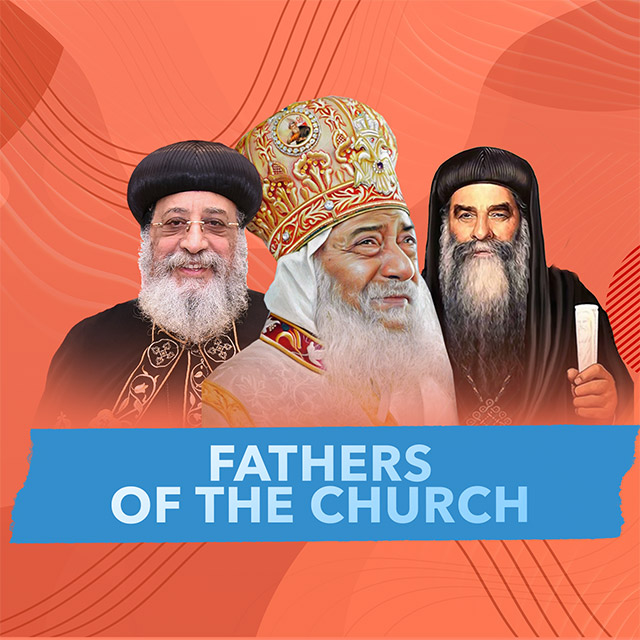The Coptic Church abounds in hymns specifically dedicated to be sung in the presence of the fathers and during processions, and they are also chanted during various occasions. The church does not glorify or honor any individual, not even the Holy Virgin Mary or all the martyrs and saints, apart from Christ. Our glorification and exaltation of the Holy Virgin is within Christ and through the mystery of the divine incarnation that occurred through her. We honor the martyrs and saints because they loved Christ, lived by His commandments, manifested His life within them, and joyfully accepted to shed their blood for Him. Therefore, the church glorifies them and rejoices in them—all of this is out of love, honor, and glorification of Christ. We glorify Christ our God through the life of the saint and martyr, and we honor the angels not for anything but because they glorify Christ our God. Christ is our life. The reception hymns in the church are not meant for the person being received, whoever they may be. The church uses the one being received—the one entering it—as an illustration to elevate the people’s gaze to their true bridegroom, Jesus Christ, their God and Lord. When the church receives the head of the clergy (bishop, metropolitan, patriarch) and sees that the people’s eyes are lifted to him, it is inspired by the Holy Spirit—the Spirit of its bridegroom—and places one of its most magnificent hymns, the Ek-esmaro’ot hymn, whose words are entirely directed to the true head of the clergy: “Blessed are You with Your Good Father and the Holy Spirit, for You have come and saved us.” The words are not directed to the bishop at all, and it is a mistake to think they are aimed at the bishop—the visible image, the representative of the priesthood of Christ. Similarly, in receiving the bridegroom on his wedding day, the church receives him with the hymn “Epouro” (O King of Peace), which is also used to receive kings in the church. Here too, the church uses the one being received as an illustration to elevate the gaze to the true King: “O King of Peace, grant us Your peace,” and so on. In the liturgical arrangement book of Pope Gabriel V, it is stated that upon the bride’s reception on the wedding day, this piece is said to the true bride, the Holy Virgin Mary: “Hail to Mary,” and so on. In the Psalm of the Gospel of the Wedding, the church lifts the gaze of the people from the earthly bridegroom to its Bridegroom, Lover, and Heart’s Desire, Christ its God, saying about Christ, “Like a bridegroom coming out of his chamber, he rejoices like a strong man to run his race,” and the intention is clearly Christ, to whom be all glory and honor. Christ is always glorified in His church (His bride), the holy and beloved one. Even on the day of the patriarch’s enthronement, he is the one who reads the ordination gospel (The Good Shepherd), and the new patriarch says, in the voice of Christ to whom be all glory and honor, “I am the Good Shepherd,” so the patriarch realizes that his shepherding of Christ’s bride is by proxy and he is not the true shepherd but rather exercises shepherding on behalf of and as an agent of the true Good Shepherd, Jesus Christ, our true God. Similarly in the priesthood, there is no priesthood in the church other than the priesthood of Christ to whom be all glory, and the priests are merely stewards of God’s mysteries. They do not practice their own priesthood but the priesthood of Christ, who is eternally present with them through His eternal priesthood. They are the stewards and visible hand of Christ, as illustrated in the story of the consecration of the altar of St. Macarius Church by Pope Benjamin II, who saw Christ’s hand extending before his to consecrate the altar. This is also evident in the ordination prayers in the Coptic Church, which clarify that there is no priesthood other than that of Christ. Thus, the hymns of the fathers are either directed to Christ, to whom be all glory in His church, or are for praying for them. This is clearly shown in the introduction of the Gospel in the presence of the fathers. The part “The Lord has sworn, … you are a priest forever” only applies to Christ to whom be all glory, while the part “The Lord is at your right hand” is a prayer for the fathers. Even in its readings, the church uses the martyr or saint being celebrated as an illustration, and blessed is the means the church uses to reveal Christ—the Holy of Holies—to its children. For example, when believers come to celebrate the feast of Saint Moses the Prophet, the chief of the prophets, as the hymns call him, they place Moses in the Psalm as a priest of Christ, and of course, Christ is the greatest. Similarly, on the feasts of the patriarchs, the church uses them to show that Christ alone is the Good Shepherd. Understanding the spirit of the church in this way will distance us from questions such as whether we should receive the fathers with hymns during the Holy Week!
Related Knowledge Base Posts
- Why do we die if Christ has redeemed us from the punishment of sin, which is death? (3 minutesread)
- Was the sin of Adam and Eve adultery? (4 minutesread)
- Are Adam and Christ similar since both are without a Father? (2 minutesread)
- Why Can’t I Confess Directly to God? (3 minutesread)
- Is the body the element of sin in man? (5 minutesread)
- How to confess our sins? (2 minutesread)
- What is the meaning of Deliberate Sin? (3 minutesread)














